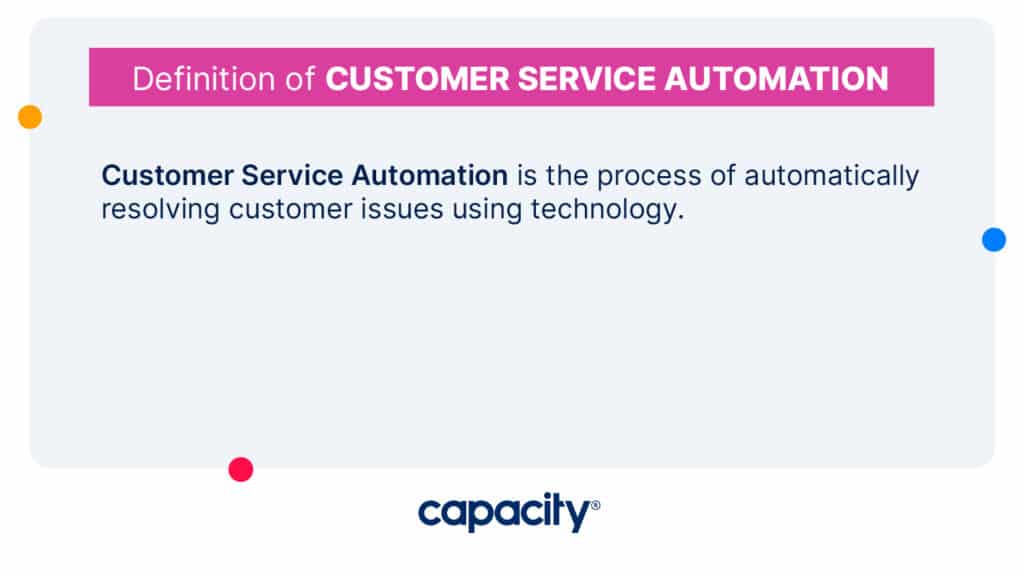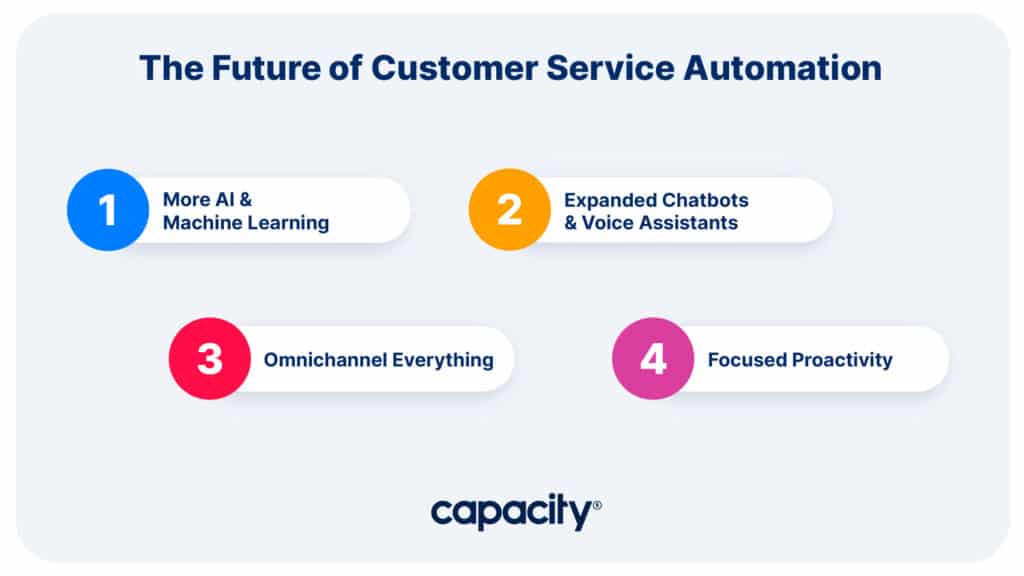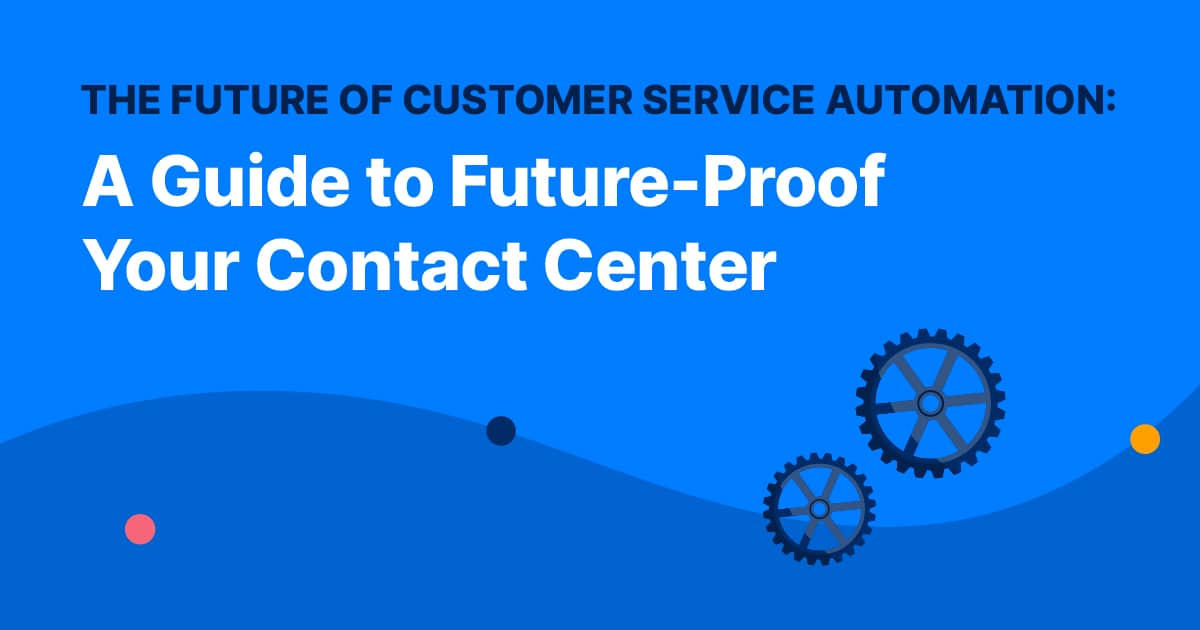We have officially entered the Jetson’s age of connectivity. Our cars can trigger an automation to open the garage and flip on the lights as we get close to home. We can start our vacuum cleaners and washing machines from 1000 miles away with a tap of the screen on our phones. And with service automation, people can get answers from businesses, like yours, without having to sit on hold. (Can I get a Hallelujah?)
Did you know that the average person spends 43 days of their life sitting on hold? I think I speak for the masses when I say: We’re over it! And I know what you’re thinking. You’re over it too. High average call volumes, wait times, and hold times do not add up to a positive (or profitable) experience. But how do you start adding customer service automation to your contact center? We’ve got you covered.
In this guide, we’ll look at what customer service automation is and how it can benefit your contact center. And then, we’ll dig into the types of solutions available today and help you decide which one might be best for your organization. Finally, we’ll wrap up by exploring potential tools you might use to get started. Let’s do this!
What is customer service automation?

Before we get into the nitty gritty on how automation changes the business terrain, let’s make sure we’re on the same page with what customer service automation means. In this guide, customer service automation refers to the process of resolving customer issues using automation technology like knowledge bases, chatbots, and the like. Its goal is to reduce the human time and effort it takes to get a customer to a resolution. And that leads to a faster average handle time, higher satisfaction, and lower cost to serve.
Customer service automation has been around for a hot minute, served up in flavors like IVRs and FAQs. But with advancements in AI and natural language processing tech storming the market, new automation platforms are making life much easier for customers and agents. Plus, they’re improving productivity and efficiency. That’s a triple scoop of a win.
Benefits of Customer Service Automation

From reducing costs and improving efficiency to boosting CSAT and delivering better experiences, many benefits come with automating customer service processes. Let’s take a look at some of the most important ones:
1. Improved efficiency:
Let’s start with the duh-factor: Service automation improves agent efficiency. (Like I said – duh.)
Automating repetitive tasks like call routing, info gathering, and appointment scheduling/rescheduling can help your contact center operate more efficiently. It frees up your agents’ time to handle more complex customer questions.
Service automation can also quickly process customer inquiries and offer up immediate responses, reducing wait times and improving satisfaction (more on that below).
2. Cost savings:
Adding service automation to your contact center also cuts costs by eliminating the need for human labor. You know that revolving door that is your contact center? Well, maybe some of that natural attrition can be replaced by automation.
What’s more, because automation can process simple customer inquiries without human intervention, your center doesn’t need to be staffed 24/7 to maintain total coverage. With the right tech in place, your customers can still get rapid (and accurate) responses, even when no humans are available.
3. Better experiences
Automation can serve faster, more accurate responses to customer questions, leading to higher satisfaction and brand loyalty.
And now, thanks to improvements in AI and machine learning, support automation can give your customers more personalized, relevant messages that are custom-fit to their specific needs. And, they do it without tagging in a human, meaning your agents have fewer…less productive…interactions. Which, of course, improves their employee experience, too.
Bonus: Automated systems can also gather data on customer interactions, giving your center better insight into customer behavior and preferences.
4. Scalability
Imagine it’s your busy season. Maybe you’re in the ed-tech space, and the back-to-school fall-pocalypse is looming. You know you’re about to get swallowed in a sudden surge of customer inquiries. Without service automation, you’d have to hire new or seasonal agents to handle the influx.
But with service automation, you can efficiently manage the high volumes without adding headcount. Automated systems can handle massive volumes of customer inquiries simultaneously, letting your contact center scale as needed without tacking on extra costs.
5. 24/7 availability
We discussed this a little above (see point 2), but setting up the right service automation processes and technology means giving your customers round-the-clock support. That means you can provide customers with the best experience, whether at 2 a.m. or 2 p.m. And you can do it without adding headcount or keeping a fully staffed center available overnight.
6. Data collection & analysis
Finally, you can use service automation to collect customer data and feedback in real-time, giving your contact center insight into what customers are really thinking. This gives you valuable intel that you can use to improve products and services or take appropriate corrective action when needed.
Types of Solutions Available on the Market
Now that we know what customer service automation is and its benefits, let’s look at how you can get started with implementing it into your contact center. There are a lot of different solutions available on the market today, but here are a few popular ones:
1. Chatbots:
It’s 2023. Almost everyone today has interacted with a chatbot at some point or another. But AI-powered chatbots use NLP and machine learning to simulate a human-to-human conversation via written messages or text chats. You can add them to your website, mobile app, or even your SMS conversations. (Shoutout to our sister company, Textel).
2. Virtual agents
Like chatbots, virtual agents are AI-powered automated programs to provide more personalized customer service experiences. They use natural language processing and machine learning algorithms to understand data patterns and analyze customer inquiries.
Once a virtual agent IDs the data, they find the most relevant response or solution by surfing your available resources, like a knowledge base.
3. Knowledge bases
A knowledge base is a centralized home for information and answers to common customer questions or issues. Usually, it contains articles or docs that provide step-by-step instructions on how to solve common issues, troubleshoot problems, or find answers to frequently asked questions. An agent, SME, or other stakeholders will often write the articles.
In service automation, the knowledge base is usually integrated with other customer service tools like chatbots or helpdesk software. This lets customers and automation quickly grab relevant information without connecting with an agent. (Psst. Not to brag, but we have a pretty cool knowledge base solution. Check it out here.)
What to Expect in the Future of Customer Service Automation
With the nearly-constant evolution of technology, too many of us are trying to shortcut our way to a better customer experience. We look at AI like the microwave that’ll heat our Pepperoni & Mozzarella Hot Pocket in a jiffy.
Look! 25 seconds on HIGH and I have a full-blown customer support strategy.
But it’s not like that. Or, it shouldn’t be as we march into the future.
AI is the tool we’ll use, but you’re the carpenter. You’re the creator of better human experiences.
Here’s a quick list of four things to expect as you future-proof your center:

1. More AI and machine learning
As AI and machine learning technologies continue improving, we expect to see more advanced customer service automation solutions that can handle even more complex customer interactions. These solutions will learn from past interactions to improve their responses and become even more capable of providing personalized, human-like interactions.
2. An expansion of chatbots and voice assistants
Chatbots and voice assistants have already begun to revolutionize how customers interact with businesses. In the future, we can expect to see even more businesses adopting these technologies to provide customers with 24/7 support, reduce wait times, and provide a more seamless experience across channels. (*Cough* like your competitors *cough*.)
3. Omnichannel everything
We already see this, but the trend is only forecasted to continue. Customers want to interact with you as they connect with their friends. They want to send a text to schedule an appointment or shoot over a chat to solve an issue. They don’t want to be tied to only one means of service from your company.
As you build out your future-proof customer experience strategy, you must account for omnichannel. Find technologies that play well with each other – something, perhaps, that integrates right into your CCaaS platform. This gives your customers a more unified experience. And it’ll help your agents’ productivity and accuracy by cutting down the number of screens they’re digging through to find information.
4. Focused proactivity
With predictive analytics, you can anticipate exactly what your customer needs before they even reach out. And that means, you can proactively offer solutions and support rather than waiting for the customer to act. As a result, your customer experience will be seamless, your CSAT will increase, and you’ll have the foresight to prevent potential issues before they become major problems.
Service Automation Tools to Future-Proof Your Contact Center
Okay, so how do you get started? I’m glad you asked. Here are a few service automation tools you can use that’ll help you knock out your competitors.
1. Capacity
Obviously, we’re a little biased. But hear me out. Capacity is an insanely powerful all-in-one AI and automation platform. We use NLP and RPA to make knowledge instantly accessible and work more efficiently and accurately.
Our AI-powered chatbots answer over 90% of repetitive questions, both internally and externally, and can integrate with email, Slack, and Microsoft Teams (and a bunch more).

Automate Your Work
Capacity’s enterprise AI chatbot can help:
- Answer FAQs anytime, anywhere
- Find relevant documents within seconds
- Give surveys and collect feedback
2. Textel
Textel is a texting platform that lives natively inside your CCaaS platform. It integrates seamlessly into RingCentral, NICE CXone, Genesys, and Salesforce, among others. The platform lets you have two-way, 1:1 conversations or send blast messages one-off or in a drip sequence. You can send mass alerts or reminders, schedule appointments, confirm shipping, and answer questions – all via text.
Its Textbot feature, powered by NLP, helps you provide instant self-service without adding to your agent queues.
3. Salesforce Service Cloud
Salesforce Service Cloud makes our list of top service automation tools because they’re just so good at automation. The platform can quickly and accurately answer customer inquiries. And it can help your customers solve their problems using your existing data.
It also collects data about your customer interactions, so you can look inside your customer’s mind a bit, helping you proactively improve your service experience.
4. Genesys Cloud
Genesys Cloud lets you handle voice, email, chat, text, and social interactions all from one platform. This gives your customers a consistent experience, no matter what channel they use to connect with you.
One of the standout features of Genesys Cloud is its use of artificial intelligence (AI) and machine learning to improve the customer experience. This lets the platform analyze large amounts of customer data in real-time and provide personalized, relevant responses to customer questions. This “intelligent automation” frees agents to focus on more complex tasks and helps reduce wait times, resulting in higher customer satisfaction.
Try Capacity (for free!) to see if service automation is right for your center.





